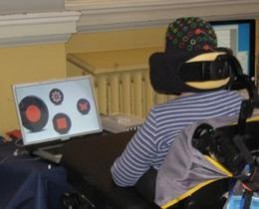Brain-computer interface allows paralyzed patients to play music
March 21, 2011 | Source: Nature News

Brain-Computer Interface (BMI) allows patients to play music by thought alone (Picture: ICCMR Research Team, University of Plymouth)
A brain-computer interface (BCI) developed by composer and computer-music specialist Eduardo Miranda of the University of Plymouth, UK, working with computer scientists at the University of Essex, allows paralyzed patients to play music just by thinking about it.
Miranda and his colleagues use electroencephalography (EEG), in which electrodes on the skull pick up faint neural signals, to enable patients to play and compose music.
Patients learn to associate particular brain signals with specific tasks through a repeating stimulus — auditory, visual or tactile — and focusing on it. This creates a distinctive, detectable pattern in the EEG signal. Miranda and his colleagues showed several flashing buttons on a computer screen, each triggering a musical event. The patients pushed a button by directing their attention to it.
For example, a button can be used to generate a melody from a preselected set of notes. The patient alters the intensity of the control signal — how hard the button is pressed — by varying the intensity of attention. The result is fed back visually as a change in the button’s size, creating a melody as if selecting keys on a piano.
Musical participation can be beneficial for people with neurodegenerative diseases such as dementia and Parkinson’s disease, says Miranda. To use Miranda’s BCI, patients still need to be able to control their eye movements, which excludes people with total locked-in syndrome.